2011 Peugeot 308 SW BL ECO mode
[x] Cancel search: ECO modePage 165 of 356
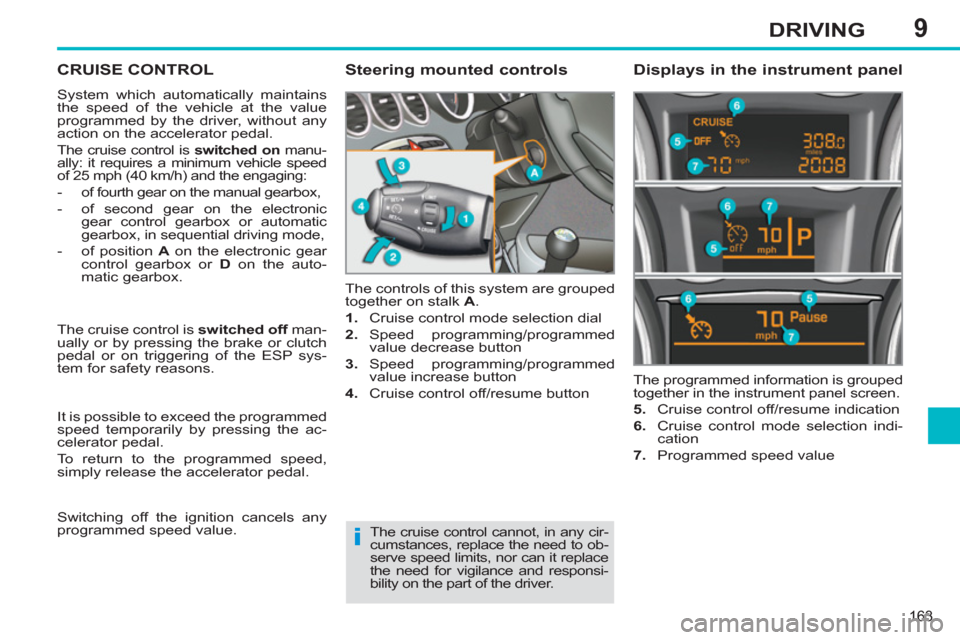
9
i
163
DRIVING
CRUISE CONTROL
System which automatically maintains
the speed of the vehicle at the value
programmed by the driver, without any
action on the accelerator pedal.
The cruise control is switched on
manu-
ally: it requires a minimum vehicle speed
of 25 mph (40 km/h) and the engaging:
- of fourth gear on the manual gearbox,
- of second gear on the electronic
gear control gearbox or automatic
gearbox, in sequential driving mode,
- of position A
on the electronic gear
control gearbox or D
on the auto-
matic gearbox.
The controls of this system are grouped
together on stalk A
.
1.
Cruise control mode selection dial
2.
Speed programming/programmed
value decrease button
3.
Speed programming/programmed
value increase button
4.
Cruise control off/resume button The programmed information is grouped
together in the instrument panel screen.
5.
Cruise control off/resume indication
6.
Cruise control mode selection indi-
cation
7.
Programmed speed value
Steering mounted controls
Displays in the instrument panel
The cruise control cannot, in any cir-
cumstances, replace the need to ob-
serve speed limits, nor can it replace
the need for vigilance and responsi-
bility on the part of the driver. The cruise control is switched off
man-
ually or by pressing the brake or clutch
pedal or on triggering of the ESP sys-
tem for safety reasons.
It is possible to exceed the programmed
speed temporarily by pressing the ac-
celerator pedal.
To return to the programmed speed,
simply release the accelerator pedal.
Switching off the ignition cancels any
programmed speed value.
Page 166 of 356
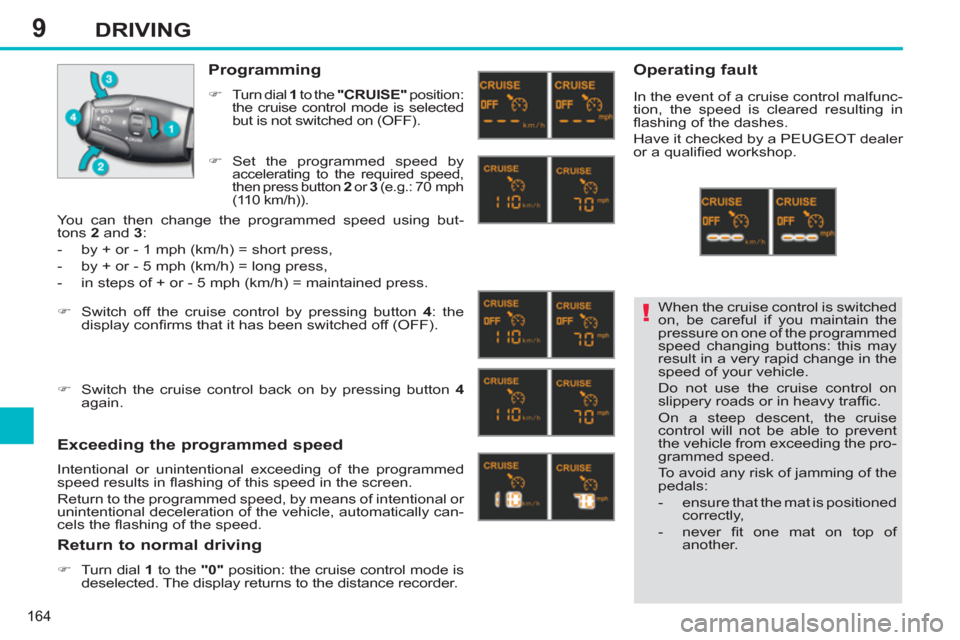
9
!
164
DRIVING
When the cruise control is switched
on, be careful if you maintain the
pressure on one of the programmed
speed changing buttons: this may
result in a very rapid change in the
speed of your vehicle.
Do not use the cruise control on
slippery roads or in heavy traffi c.
On a steep descent, the cruise
control will not be able to prevent
the vehicle from exceeding the pro-
grammed speed.
To avoid any risk of jamming of the
pedals:
- ensure that the mat is positioned
correctly,
- never fi t one mat on top of
another.
Programming
�)
Turn dial 1
to the "CRUISE"
position:
the cruise control mode is selected
but is not switched on (OFF).
Exceeding the programmed speed
Intentional or unintentional exceeding of the programmed
speed results in fl ashing of this speed in the screen.
Return to the programmed speed, by means of intentional or
unintentional deceleration of the vehicle, automatically can-
cels the fl ashing of the speed.
Return to normal driving
�)
Turn dial 1
to the "0"
position: the cruise control mode is
deselected. The display returns to the distance recorder.
Operating fault
In the event of a cruise control malfunc-
tion, the speed is cleared resulting in
fl ashing of the dashes.
Have it checked by a PEUGEOT dealer
or a qualifi ed workshop.
�)
Set the programmed speed by
accelerating to the required speed,
then press button 2
or 3
(e.g.: 70 mph
(110 km/h)).
�)
Switch off the cruise control by pressing button 4
: the
display confi rms that it has been switched off (OFF).
�)
Switch the cruise control back on by pressing button 4
again.
You can then change the programmed speed using but-
tons 2
and 3
:
- by + or - 1 mph (km/h) = short press,
- by + or - 5 mph (km/h) = long press,
- in steps of + or - 5 mph (km/h) = maintained press.
Page 208 of 356
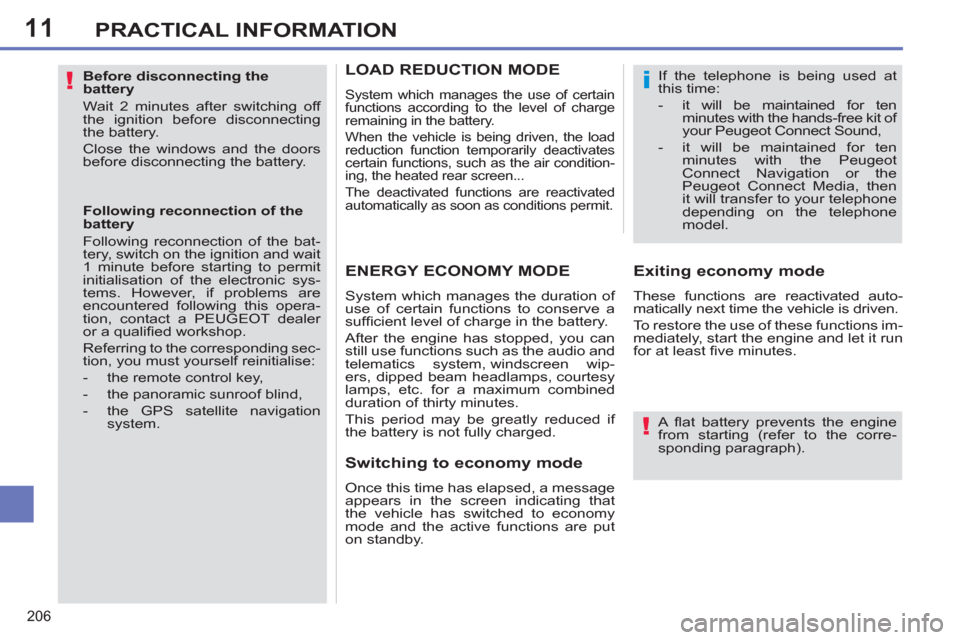
11
!
!
i
206
PRACTICAL INFORMATION
Before disconnecting the
battery
Wait 2 minutes after switching off
the ignition before disconnecting
the battery.
Close the windows and the doors
before disconnecting the battery.
Following reconnection of the
battery
Following reconnection of the bat-
tery, switch on the ignition and wait
1 minute before starting to permit
initialisation of the electronic sys-
tems. However, if problems are
encountered following this opera-
tion, contact a PEUGEOT dealer
or a qualifi ed workshop.
Referring to the corresponding sec-
tion, you must yourself reinitialise:
- the remote control key,
- the panoramic sunroof blind,
- the GPS satellite navigation
system.
A fl at battery prevents the engine
from starting (refer to the corre-
sponding paragraph). If the telephone is being used at
this time:
- it will be maintained for ten
minutes with the hands-free kit of
your Peugeot Connect Sound,
- it will be maintained for ten
minutes with the Peugeot
Connect Navigation or the
Peugeot Connect Media, then
it will transfer to your telephone
depending on the telephone
model.
ENERGY ECONOMY MODE
System which manages the duration of
use of certain functions to conserve a
suffi cient level of charge in the battery.
After the engine has stopped, you can
still use functions such as the audio and
telematics system, windscreen wip-
ers, dipped beam headlamps, courtesy
lamps, etc. for a maximum combined
duration of thirty minutes.
This period may be greatly reduced if
the battery is not fully charged.
Exiting economy mode
These functions are reactivated auto-
matically next time the vehicle is driven.
To restore the use of these functions im-
mediately, start the engine and let it run
for at least fi ve minutes.
Switching to economy mode
Once this time has elapsed, a message
appears in the screen indicating that
the vehicle has switched to economy
mode and the active functions are put
on standby.
LOAD REDUCTION MODE
System which manages the use of certain
functions according to the level of charge
remaining in the battery.
When the vehicle is being driven, the load
reduction function temporarily deactivates
certain functions, such as the air condition-
ing, the heated rear screen...
The deactivated functions are reactivated
automatically as soon as conditions permit.
Page 220 of 356

12
218
TECHNICAL DATA
*
The weight of the braked trailer can be increased, within the GTW limit, if the GVW of the towing vehicle is reduced by an
equal amount; warning, towing using a lightly loaded towing vehicle may have an adverse effect on its road holding.
The GTW and towed load values indicated are valid up to a maximum altitude of 1 000 metres; the towed load mentioned
must be reduced by 10 % for each additional 1 000 metres of altitude.
The speed of a towing vehicle must not exceed 60 mph (100 km/h) (comply with the legislation in force in your country).
High ambient temperatures may result in a reduction in the performance of the vehicle to protect the engine; if the ambient
temperature is above 37 °C, limit the towed load.
WEIGHTS AND TOWED LOADS (in kg)
Petrol engines
1.4 litre VTi
98 hp
1.6 litre 16V
110 hp
1.6 litre VTi 120 hp
Gearboxes
Manual
Manual
Manual
Automatic
Model codes:
4C...
8FR-0
N6A-C
N6A-5
-
5FS-0
-
5FS-9
- Unladen weight
1 271
1 302
-
1 287
-
1 312
- Kerb weight
1 346
1 377
-
1 362
-
1 387
- Payload
509
518
-
528
-
523
- Gross vehicle weight (GVW)
1 780
1 820
-
1 815
-
1 835
- Gross train weight (GTW)
on a 12% gradient
2 980
3 020
-
3 315
-
3 085
- Braked trailer (within GTW limit)
on a 10% or 12% gradient
1 200
1 200
-
1 500
-
1 250
- Braked trailer * (with load transfer
within the GTW limit)
1 450
1 450
-
1 500
-
1 500
- Unbraked trailer
670
685
-
680
-
690
- Recommended nose weight
60
60
-
76
-
60
Page 221 of 356

12
219
TECHNICAL DATA
WEIGHTS AND TOWED LOADS (in kg)
Petrol engines
1.6 litre THP
150 hp
1.6 litre THP 156 hp
1.6 litre THP
163 hp
1.6 litre THP
200 hp
Gearboxes
Automatic
Manual
Automatic
Automatic
Manual
Model codes:
4C...
5FE-J
5FV-8
5FV-A
5FM-J
5FU-8
- Unladen weight
1 358
1 315
1 368
1 358
1 399
- Kerb weight
1 433
1 390
1 443
1 433
1 474
- Payload
502
525
502
502
451
- Gross vehicle weight (GVW)
1 860
1 840
1 870
1 860
1 850
- Gross train weight (GTW)
on a 12% gradient
2 660
3 390
3 470
2 660
1 850
- Braked trailer (within GTW limit)
on a 10% or 12% gradient
800
1 550
1 600
800
X
- Braked trailer * (with load transfer
within the GTW limit)
800
1 650
1 650
800
X
- Unbraked trailer
710
695
720
710
X
- Recommended nose weight
65
70
70
65
X
The GTW and towed load values indicated are valid up to a maximum altitude of 1 000 metres; the towed load mentioned
must be reduced by 10 % for each additional 1 000 metres of altitude.
The speed of a towing vehicle must not exceed 60 mph (100 km/h) (comply with the legislation in force in your country).
High ambient temperatures may result in a reduction in the performance of the vehicle to protect the engine; if the ambient
temperature is above 37 °C, limit the towed load. *
The weight of the braked trailer can be increased, within the GTW limit, if the GVW of the towing vehicle is reduced by an
equal amount; warning, towing using a lightly loaded towing vehicle may have an adverse effect on its road holding.
Page 222 of 356

12
220
TECHNICAL DATA
The GTW and towed load values indicated are valid up to a maximum altitude of 1 000 metres; the towed load mentioned
must be reduced by 10 % for each additional 1 000 metres of altitude.
The speed of a towing vehicle must not exceed 60 mph (100 km/h) (comply with the legislation in force in your country).
High ambient temperatures may result in a reduction in the performance of the vehicle to protect the engine; if the ambient
temperature is above 37 °C, limit the towed load. *
The weight of the braked trailer can be increased, within the GTW limit, if the GVW of the towing vehicle is reduced by an
equal amount; warning, towing using a lightly loaded towing vehicle may have an adverse effect on its road holding.
WEIGHTS AND TOWED LOADS (in kg)
Petrol engines
1.4 litre VTi
98 hp
1.6 litre 16V
110 hp
1.6 litre VTi 120 hp
Gearboxes
Manual
Manual
Manual
Automatic
Model codes: 4E...
8FR-0
N6A-C
N6A-5
-
5FS-0
-
5FS-9
- Unladen weight
1 320
1 374
-
1 320
-
1 356
- Kerb weight
1 395
1 449
-
1 395
-
1 431
- Payload
600
576
-
602
-
592
- Gross vehicle weight (GVW)
1 920
1 950
-
1 922
-
1 948
- Gross train weight (GTW)
on a 12% gradient
3 020
3 150
-
3 272
-
3 298
- Braked trailer (within GTW limit)
on a 10% or 12% gradient
1 100
1 200
-
1 350
-
1 350
- Braked trailer * (with load transfer
within the GTW limit)
1 100
1 400
-
1 500
-
1 500
- Unbraked trailer
695
720
-
695
-
715
- Recommended nose weight
60
75
-
65
-
60
Page 223 of 356
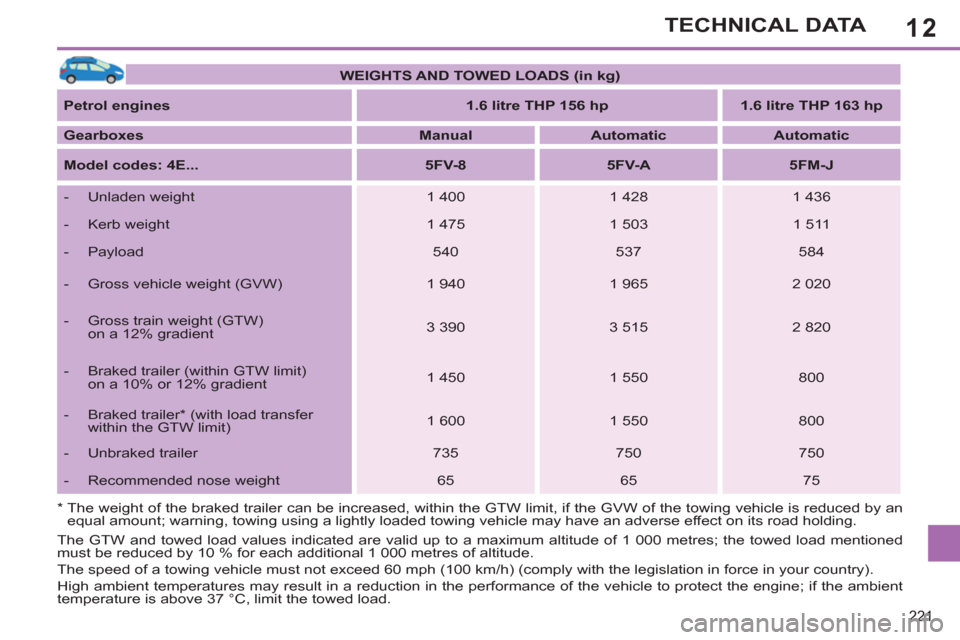
12
221
TECHNICAL DATA
The GTW and towed load values indicated are valid up to a maximum altitude of 1 000 metres; the towed load mentioned
must be reduced by 10 % for each additional 1 000 metres of altitude.
The speed of a towing vehicle must not exceed 60 mph (100 km/h) (comply with the legislation in force in your country).
High ambient temperatures may result in a reduction in the performance of the vehicle to protect the engine; if the ambient
temperature is above 37 °C, limit the towed load. *
The weight of the braked trailer can be increased, within the GTW limit, if the GVW of the towing vehicle is reduced by an
equal amount; warning, towing using a lightly loaded towing vehicle may have an adverse effect on its road holding.
WEIGHTS AND TOWED LOADS (in kg)
Petrol engines
1.6 litre THP 156 hp
1.6 litre THP 163 hp
Gearboxes
Manual
Automatic
Automatic
Model codes: 4E...
5FV-8
5FV-A
5FM-J
- Unladen weight
1 400
1 428
1 436
- Kerb weight
1 475
1 503
1 511
- Payload
540
537
584
- Gross vehicle weight (GVW)
1 940
1 965
2 020
- Gross train weight (GTW)
on a 12% gradient
3 390
3 515
2 820
- Braked trailer (within GTW limit)
on a 10% or 12% gradient
1 450
1 550
800
- Braked trailer * (with load transfer
within the GTW limit)
1 600
1 550
800
- Unbraked trailer
735
750
750
- Recommended nose weight
65
65
75
Page 224 of 356
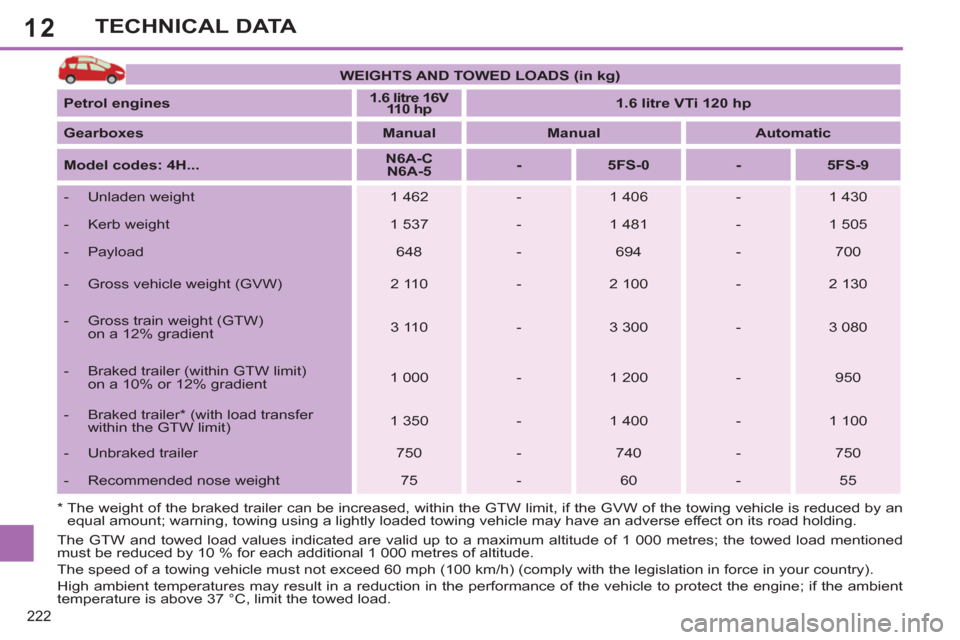
12
222
TECHNICAL DATA
The GTW and towed load values indicated are valid up to a maximum altitude of 1 000 metres; the towed load mentioned
must be reduced by 10 % for each additional 1 000 metres of altitude.
The speed of a towing vehicle must not exceed 60 mph (100 km/h) (comply with the legislation in force in your country).
High ambient temperatures may result in a reduction in the performance of the vehicle to protect the engine; if the ambient
temperature is above 37 °C, limit the towed load. *
The weight of the braked trailer can be increased, within the GTW limit, if the GVW of the towing vehicle is reduced by an
equal amount; warning, towing using a lightly loaded towing vehicle may have an adverse effect on its road holding.
WEIGHTS AND TOWED LOADS (in kg)
Petrol engines
1.6 litre 16V
110 hp
1.6 litre VTi 120 hp
Gearboxes
Manual
Manual
Automatic
Model codes: 4H...
N6A-C
N6A-5
-
5FS-0
-
5FS-9
- Unladen weight
1 462
-
1 406
-
1 430
- Kerb weight
1 537
-
1 481
-
1 505
- Payload
648
-
694
-
700
- Gross vehicle weight (GVW)
2 110
-
2 100
-
2 130
- Gross train weight (GTW)
on a 12% gradient
3 110
-
3 300
-
3 080
- Braked trailer (within GTW limit)
on a 10% or 12% gradient
1 000
-
1 200
-
950
- Braked trailer * (with load transfer
within the GTW limit)
1 350
-
1 400
-
1 100
- Unbraked trailer
750
-
740
-
750
- Recommended nose weight
75
-
60
-
55